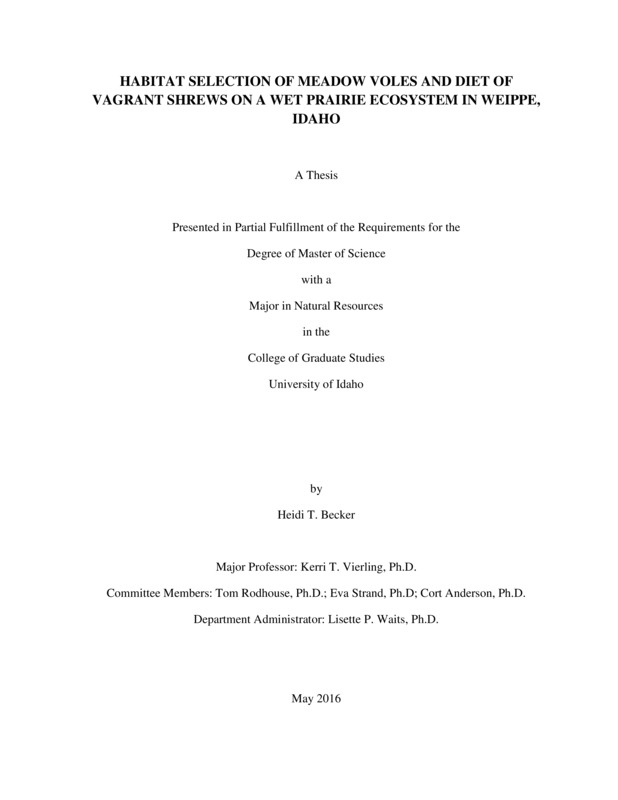Habitat Selection of Meadow Voles and Diet of Vagrant Shrews On A Wet Prairie Ecosystem in Weippe, Idaho
Becker, Heidi. (2016). Habitat Selection of Meadow Voles and Diet of Vagrant Shrews On A Wet Prairie Ecosystem in Weippe, Idaho. Theses and Dissertations Collection, University of Idaho Library Digital Collections. https://www.lib.uidaho.edu/digital/etd/items/becker_idaho_0089n_10784.html
- Title:
- Habitat Selection of Meadow Voles and Diet of Vagrant Shrews On A Wet Prairie Ecosystem in Weippe, Idaho
- Author:
- Becker, Heidi
- Date:
- 2016
- Keywords:
- diet analysis DNA barcoding habitat selection meadow voles occupancy modelling vagrant shrews
- Program:
- Natural Resources
- Subject Category:
- Natural resource management
- Abstract:
-
Wetlands are among the most productive ecosystems in the world, providing a variety of functions including water purification and habitat for fish and wildlife. Despite this importance, their presence has declined drastically due to modifications such as agricultural conversion and urban development. Those areas that remain are often not pristine, but subject to deliberate or accidental modification consequent from altered land-use patterns, e.g. agricultural conversion. To prevent further decline of wetlands, many of these modified areas are undergoing restoration efforts. However, determination of the species present, and how these interact with their environment must be understood in order for an area to be successfully restored. Small mammals play important roles in wetland ecosystems, such as wet prairies; they exert predatory pressure on invertebrates and other small mammals, provide a vital prey base, and have significant influences on vegetation and soil. The purpose of this study was to analyze habitat selection of meadow voles and the diet of vagrant shrews on a wet prairie ecosystem in northern Idaho projected to undergo restoration work. The focus of planned restoration efforts is to increase the presence of small camas (Camassia quamash), a native, facultative wetland species. Our specific goal was to determine how restoration activities might influence these small mammal species, in order to inform management decisions.
Results from three years of occupancy modeling indicated that meadow voles preferred areas containing meadow foxtail (Alopecuris pratensis), a nonnative pasture grass that dominates the site. Conversely, our results show that meadow vole presence is negatively associated with small camas, a relationship not previously recognized. The DNA barcoding method used for diet analysis revealed the occurrence of direct or indirect consumption of plants by vagrant shrews. This method has not previously been used on vagrant shrews and provided more precise identification of diet components. In conclusion, our study provides an expansion of what is known about small mammals in a wet prairie ecosystem.
- Description:
- masters, M.S., Natural Resources -- University of Idaho - College of Graduate Studies, 2016
- Major Professor:
- Vierling, Kerri T
- Committee:
- Rodhouse, Thomas J; Anderson, Cort L; Strand, Eva K
- Defense Date:
- 2016
- Identifier:
- Becker_idaho_0089N_10784
- Type:
- Text
- Format Original:
- Format:
- application/pdf
- Rights:
- In Copyright - Educational Use Permitted. For more information, please contact University of Idaho Library Special Collections and Archives Department at libspec@uidaho.edu.
- Standardized Rights:
- http://rightsstatements.org/vocab/InC-EDU/1.0/

